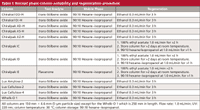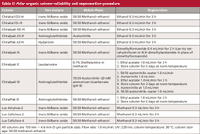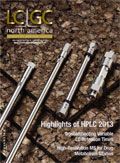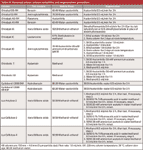A Multimodal Liquid and Supercritical Fluid Chromatography Chiral Separation Screening and Column Maintenance Strategy Designed to Support Molecules in Pharmaceutical Development, Part II
LCGC North America
The establishment of a system suitability plan that focuses on the maintenance of the most important variable in any chiral separation screen - the column - is presented.
Chiral separation screening has become a widely accepted approach for the rapid identification of an appropriate chiral stationary phase for use in more focused enantioseparation optimization. A set of extended screens encompassing various chromatographic modes using high performance liquid chromatography (HPLC) and supercritical fluid chromatography (SFC) is presented. These multimodal screens are tailored to meet the specific and changing needs of customers as distributed along the drug development process within a typical pharmaceutical development setting. In addition, a systematic column testing and regeneration approach is presented and emphasized for maintaining the reliability of column and screen data. Comprehensive screening systems created to serve such an expansive customer base, actively supported with manufacturer-recommended column suitability and regeneration procedures, are not well represented in the literature.
The overarching aim of any chiral separation screening operation within the typical pharmaceutical analytical laboratory is the identification of the more promising chiral stationary phase (CSP) and eluent combinations from which the ideal enantioseparation can be optimized. In part I of this article, we reviewed various screens reported in the literature and compared them to the generally broader screens used in our laboratory (1). The unique position of our operation with respect to the drug development pipeline (serving both discovery phase and precommercialization functions) necessitates the use of an extended multimodal screening plan to address the needs of a diverse customer base. The requirements of the early-phase research chemist with preparative chromatography needs differ notably from the requirements of the later-phase analyst who needs to monitor the enantiomeric purity of an expensive good manufacturing practice (GMP) drug campaign. One size does not fit all.

Most of the screens reported in the literature have been constructed to supply the needs of the discovery-phase synthetic chemist. The end goal with these customers is commonly either a separation from which preparative conditions are derived, or a method that can quickly measure the chiral purity of preparative fractions or the product of an asymmetric synthesis. Frequently, the logistics of these discovery-stage operations dictate that the same laboratory that conducts the chiral separation screen is also the laboratory that performs the follow-on sample analysis. Depending on the available CSP and instrument resources, such analyses might be conducted using columns that have experienced multiple injections and various mobile phases, and possibly even the screening columns themselves. Such a scenario is usually acceptable, given the limited requirements of the customer. In other words, column performance and separation reproducibility are of lesser importance, as long as an enantiopurity assessment can be obtained.
The scrutiny concerning a CSP's performance is greatly increased for the customer who needs a rugged and reliable separation recipe that will work from column-to-column and site-to-site. In such cases, the quality of the separation provided is key and methodology should be developed on a column untainted by previous work. There are few experiences more painful in the world of chiral separations than providing an impressive enantioseparation method to the customer, only to learn later that the separation cannot be produced on other chiral columns of the same class. To combat this problem, our laboratory has instituted a plan in which all CSPs, used both for screening and separation optimization, are routinely tested against a respective documented separation standard.
Experimental
Instrumentation
Various instrumentation formats are used with each platform dedicated to screening operations in a specific chromatographic mode. All normal-phase and some polar-organic and reversed-phase mode screening are conducted using an Agilent 1100 series high performance liquid chromatography (HPLC) system equipped with an autosampler and a photodiode-array detector controlled by Empower software (Waters). Two external six-port Power Selector Elite column switchers (Analytical Sales & Services) allow for sequential screening using 12 different CSPs. Additional polar-organic and reversed-phase screening platforms use Agilent 1260 Infinity series HPLC systems with two 1290 Infinity four-port column switchers and Agilent Chemstation software.
Supercritical fluid chromatography (SFC) instrumentation consists of an Agilent 1100 series HPLC system equipped with an autosampler and a photodiode-array detector mated to a Fusion A5 SFC module controlled by Chemstation software. A 12-column screening capability is provided by two Power Selector Elite six-port column switchers. The SFC and 1260 Infinity platforms are augmented with Agilent 12/13 12-port solvent selector valves, allowing for screening using a variety of eluent combinations.
Chiral Stationary Phases
The polysaccharide-based Chiralcel and Chiralpak CSPs were purchased from Chiral Technologies Inc. Lux Amylose-2, Cellulose-2, and Cellulose-4 polysaccharide columns were obtained from Phenomenex Inc. Regis Technologies Inc., provided the Whelk-O 1 brush-type CSP. The macrocyclic antibiotic Chirobiotic columns, Cyclobond I 2000 cyclodextrin-based CSPs, and the polymeric PCAP column were purchased from Supelco Analytical. All columns used in the screens are composed of 5-μm particle size material, measure 4.6 mm in diameter and 150 mm in length, except for the Whelk-O 1 (250 mm).
Materials
HPLC-grade solvents (purity of 99% or greater unless indicated otherwise) are used for all chromatographic screens, separation suitability tests and column regeneration regimens. Acetonitrile and methanol were obtained from EMD Millipore Corporation. Ethanol (200 proof) was purchased from Decon Labs, Inc. Isopropanol and n-hexane (95%) were purchased from Fisher Scientific, Inc. N,N-Dimethylformamide was acquired from Fluka Chemical Corporation. Ethyl acetate was purchased from Honeywell Burdick & Jackson Inc. Deionized water was supplied through a centralized laboratory purification system. USP-grade carbon dioxide was acquired from Airgas Mid America.
The basic eluent additives were diethylamine, purchased from Sigma-Aldrich Corporation, and triethylamine, from EMD Millipore Corporation. The acidic eluent additive trifluoroacetic acid was acquired from Alfa Aesar. The chiral analytes used for HPLC column suitability tests were obtained from various suppliers. DL-Aminoglutethimide was purchased from Tokyo Chemical Industry Co. Ltd. DL-Laudanosine was acquired from Biosynth Chemistry and Biology International. 1,1'-Bi-2-naphthol and trans-stilbene oxide were acquired from Acros Organics. Benzoin, hydrobenzoin, flavanone, and 5-methyl-5-phenylhydantoin were purchased from Sigma-Aldrich.
Chiral Column Suitability Assessment
Using a combination of manufacturer guidance, literature reports, and laboratory experimentation, the authors have developed a standardized process for the evaluation of all CSPs incorporated within our chiral separation screens. Following these established guidelines, each respective chiral column is routinely performance-tested against a preselected chiral analyte using a tailored set of analysis conditions. When a dedicated column incorporated into a screen happens to use the same chromatographic mode in which the column was shipped, the test analyte and separation system used for suitability testing is often adopted directly from the column manufacturer. Minor adjustments in mobile-phase composition or system conditions are sometimes made to standardize the suitability tests of columns within a specific chromatographic mode.
Retention and separation parameters for each column, to include resolution and selectivity, are tracked over time. If a particular column's performance deteriorates noticeably, then the respective CSP is passed through a specified regeneration procedure (provided by the manufacturer) and then retested. If a column fails to respond, it is discarded. Though the authors do not impose a rigid "pass/fail" set of criteria for continuing a column's use, parameter variations of 20% or greater are cause for concern. Such a monitoring scheme, though not guaranteed to locate problematic columns immediately at failure, is certainly preferable to the extended operation of chiral screens with no periodic column testing regimen in place.
The appropriate frequency for conducting CSP suitability testing depends on several factors, three of which are mentioned here. Not surprisingly, sample throughput plays a role. Simply put, the greater the number of samples that pass along a given column, the greater the likelihood of phase contamination. Another consideration is sample quality. Samples containing retentive impurities or extraneous recipients can very quickly degrade the performance of a chiral column. Not enough can be said concerning the benefits of sample pretreatment when using expensive and sensitive CSPs. The use of guard columns when available serve as another deterrent against CSP contamination. Finally, the care given to a chiral column after use is also important. By rinsing a respective column thoroughly in an acceptable storage solvent within the mode it is routinely used, the chances of extended phase life are notably increased. In summary, the frequency of column suitability testing must reflect the demands placed on the screening system. Considering the implications of using faulty columns in screening or optimization efforts, a conservative approach is warranted.
Normal-Phase Mode Column Suitability
The column suitability testing and regeneration procedures supporting our normal-phase screening system are shown in Table I. Of the various suitability tests across the differing chromatographic modes, the test conditions for these CSPs in the normal-phase mode are the most alike. Since all of the columns are shipped from the manufacturer stored in normal-phase solvents, and their corresponding recommended suitability separations are naturally in this same mode, all are used by our laboratory without modification. With the exception of one column that uses flavanone, all columns use trans-stilbene oxide as the suitability analyte.

Table I: Normal phase column suitability and regeneration procedure
Polar-Organic Mode Column Suitability
The HPLC columns in the polar-organic screen, as in all of our screens, are dedicated to that particular chromatographic mode. Experience has demonstrated that conversion of coated CSPs back and forth between modes can be deleterious to longer term column performance. Coated CSPs represent a significant proportion of the columns used in many of our screens. Hence, the suitability testing of a given column within the mode in which it is used is desired. Unfortunately, literature from chiral column manufacturers generally include only normal-phase test separations for their columns (when the CSP is amenable to normal phase), despite their frequent applicability for use in other chromatographic modes. As a result, polar-organic mode suitability enantioseparations needed to be identified for all columns used in the polar-organic mode screen. This involved literature research and also frequently entailed laboratory experimentation. In an effort to minimize the number of analytes required for the overall testing process across screens and modes, it seemed logical to develop separations, when possible, that shared the same test analyte across multiple columns.
Because all but one column used in the normal-phase mode screen use trans-stilbene oxide as the analyte for the suitability test, logic dictates that the corresponding polar-organic mode suitability system should use this analyte if possible. Fortunately, seven columns successfully separate trans-stilbene oxide enantiomers using a polar-organic mobile phase of 50:50 methanol–ethanol. Three columns share aminoglutethimide as a suitability analyte, with the remaining CSPs using unique analytes. The column suitability testing and regeneration procedures supporting our polar organic screening system are shown in Table II.

Table II: Polar organic column suitability and regeneration procedure
Reversed-Phase Mode Column Suitability
The reversed-phase component of our chiral separation screening function is the most expansive, incorporating many of the same columns represented in other modes, with the addition of more focused CSPs based upon β-cyclodextrins and macrocyclic antibiotics. Of the 14 columns, only four were specifically tailored for reversed-phase operation. These coated columns use the same ligands as their "H" counterparts that are represented in the normal-phase and polar-organic screens, but are designed specifically for reversed-phase use and consequently are supplied with suitable reversed-phase suitability systems from the manufacturer (Table III). The cyclodextrin-based CSPs are not limited to the reversed-phase mode, but are supplied with suitability separations in this system likely because of their effectiveness in hydro-organic eluent systems. The remaining column class not present in the normal-phase and polar-organic screens is the macrocyclic antibiotic type. These are supplied with suitability injections using methanol as an eluent (polar-organic mode), likely due to the columns' analogous recommended storage in the same solvent.

Table III: Reversed phase column suitability and regeneration procedure
The remaining polysaccharide columns are shipped in normal-phase solvents along with their respective test enantioseparations in that solvent mode. Because these columns are also used in our polar-organic mode screen, and use tailored suitability separations developed in the polar-organic mode (a mode compatible with reversed-phase solvents), these same suitability testing systems are also used for our dedicated reversed-phase columns. Despite this approach, reversed-phase suitability across such a diverse column set still required the use of seven different analytes, four of them unique to this chromatographic mode. For the purpose of harmonization, a suitable storage solvent was chosen (80:20 methanol–water) for the 14 columns, instead of following the specific storage guidelines for each respective CSP. Despite this alteration in column storage solvent, the authors have not observed CSP degradation as a result of this practice. This greatly facilitates the rinsing and storage of the columns after the reversed phase automated screen. The column suitability and regeneration procedures supporting our reversed-phase screening system are shown in Table III.
Polar-Ionic and Supercritical Fluid Column Suitability
For the remaining two chromatographic modes addressed in our screens (polar ionic and SFC), the previously described polar-organic and reversed-phase suitability processes address most columns used in these additional screens. Specifically, the polar-ionic screen consists of macrocyclic antibiotic and cyclodextrin-based columns, all of which are also used within the reversed-phase screen. Using the reversed-phase suitability tests for these CSPs is an adequate test of column functionality. Multiple options exist for the suitability testing of SFC dedicated columns. Although an obvious choice is to assess the respective columns via established SFC methodology, another, perhaps more efficient, option is available. During operation, the mobile-phase environment of SFC closely mimics normal-phase chromatography, with carbon dioxide basically fulfilling a similar role as a nonpolar solvent such as hexane or heptane. Columns in the SFC screen, however, are never actually exposed to these lipophilic solvents. In fact, while not under supercritical flow and pressure, the CSPs are saturated in the respective alcohol modifier in which they were last exposed. In the case of our system, methanol remains in the respective column as a by-product of the carbon dioxide–methanol rinse used after every screen.
In summary, SFC columns are stored in a solvent inherent to the polar-organic mode and, therefore, suitability testing in this mode seems most appropriate for SFC-dedicated columns. Because nine of the 12 columns used in our SFC screen are also used in the polar-organic screen, suitability conditions are shared. Such a system also allows for comparing the column efficiency of like columns being used across both chromatographic modes. The only difference is storage solvent, with SFC columns stored in methanol as opposed to the mixed-alcohol storage solvent used for polar-organic dedicated columns. Column suitability testing, storage, and regeneration procedures for the three CSPs in the SFC screen that are not already represented in the polar-organic screen setup are provided in Table IV.

Table IV: Supercritical fluid column suitability and regeneration procedure
Concept Application
The development of a standardized HPLC column suitability testing, regeneration, and storage procedure supporting multiple CSPs and chromatographic modes is no small task and requires significant resources for both its establishment and maintenance. That said, to conduct chiral separation screening using degraded and unreliable columns can actually prove more costly in the long run. Two examples of successful column regenerations demonstrate the value of such a controlled column testing and maintenance scheme. In the first, a CSP in the reversed-phase screen was identified within a routine check as not separating the compound flavanone, the chosen analyte for suitability testing. In fact, minimal isomer separation was observed before column regeneration. The standard regeneration procedure, though admittedly simple (rinse with acetonitrile), proved quite effective.
In another example, a very heavily used column demonstrated poor performance in the resolution of trans-stilbene oxide when suitability testing was done in the normal-phase mode. Two iterations of the respective regeneration procedure were conducted, with each resulting in limited improvement in column performance. The enantioseparation of trans-stilbene oxide after regeneration improved over what was originally observed, but peak bandwidth was certainly not as tight as seen with the CSP when it was new. In cases such as this, when a column is only partially returned to its initial performance level, the authors discard the column.
Chiral Method Development
The selected set of columns and mobile phases that constitute the chiral screen define a wide chromatographic space that is very likely to contain solutions for a majority of the chiral separation problems encountered by scientists in pharmaceutical research and development. An essential part of the screening strategy is the set of criteria used to evaluate the quality of the chromatographic separations that result from its execution. Rational choices between the different stationary and mobile phase combinations are made by assessing selectivity or resolution, peak asymmetry, sensitivity, analysis time, and elution order. Phase-appropriate criteria are summarized in Table V. The target values designated as "Early Development" are suited for preclinical efforts, in which the objective is to define the conditions capable of separating the enantiomers of interest. Primary uses of chiral methods in this stage of the development pipeline include material purification, determination of enantiomer identity, and determination of enantiomer stability or conversion. The target values labeled as "Later Development" are more demanding and reflect the requirements of methods designed to separate the enantiomers from other impurities that may be present in the material and provide a quantitative determination of the minor enantiomer. Methods satisfying these guidelines are useful in assessing the chiral purity of reagents, starting materials, and intermediates essential to support primary stability studies or release batches intended for use in pivotal clinical studies.

Table V: Chromatographic performance guidelines
Chiral HPLC method development is performed in stages that can be described as screening, optimization, and characterization, incorporating analytical quality-by-design principles. As outlined in previous sections of this report, screening involves separating the enantiomers of interest using an extended range of column and mobile-phase combinations. The goal in these experiments is to identify chiral stationary- and mobile-phase combinations that demonstrate at least some success in resolving the enantiomers and satisfying the other design criteria. Multiple column or mobile-phase combinations may be selected for subsequent evaluation. In the optimization stage that follows, operating parameters such as mobile-phase composition, column temperature, detection settings, and sample preparation procedures are adjusted to achieve the desired method performance. The scope of these studies can vary greatly based on the complexity of the separation problem. The number of analytes under evaluation may increase in this stage to include other components expected to be present in the sample matrix (for example, excipients, impurities, and reaction solvents). These experiments result in a set of method conditions that satisfy the design criteria of Table V. When desired, the performance of the method is characterized. This final stage produces a data package that supports the intended use of the method and includes the evaluation of specificity, linearity, accuracy, precision, and sensitivity as appropriate.
Conclusions
The use of chiral HPLC and SFC separation screening platforms has become an accepted practice within the pharmaceutical industry for the rapid identification of promising enantioseparation systems. To maintain the reliability of data derived from these screens, care must be taken to ensure that the HPLC columns used are functioning optimally, demonstrating selectivity and efficiency near that of a pristine example. The use of contaminated and nonrepresentative columns within a screen can result in missed enantioseparation "hits" or erroneous separations that may not prove reproducible with other columns. Through the implementation of a detailed column suitability and regeneration system in which screening columns are routinely tested and compared to a standard, the quality and reliability of the data from a chiral separation screening process becomes much more reliable.
References
(1) V.S. Sharp, N. Hicks, and J. Stafford, LCGC North Am. 31(8), 622–628 (2013).
V. Scott Sharp and Nicole Hicks are with the product design and developability group in drug product development at Eli Lilly and Company in Indianapolis, Indiana.
John Stafford is with product and process performance in analytical sciences research and development at Eli Lilly and Company.
Direct correspondence to: vss@lilly.com

The 26th Norwegian Symposium on Chromatography
March 29th 2024The 26th Norwegian Symposium on Chromatography was held 21–23 January 2024. The symposium has strong traditions in the Norwegian separation science community, serving as a forum for excellent scientific talks, networking, and social events.






